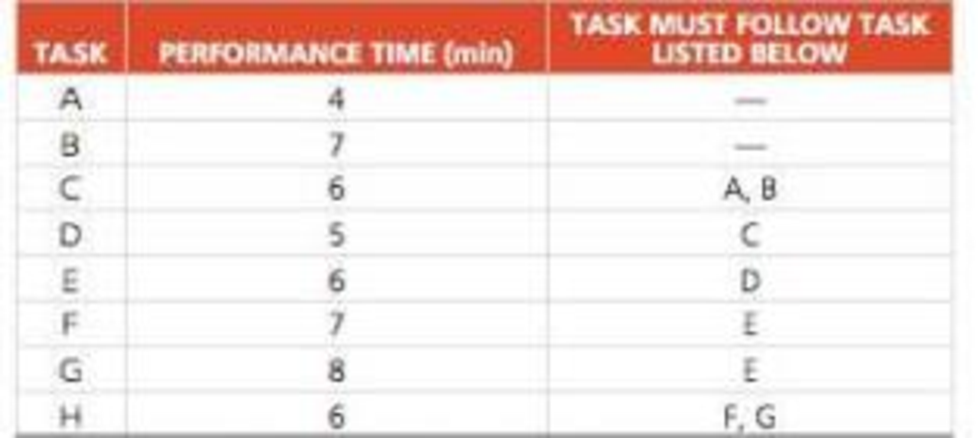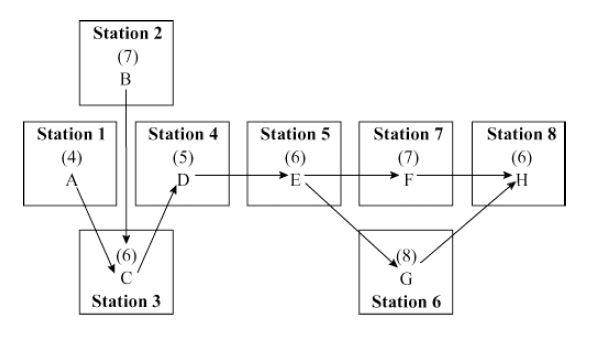
Concept explainers
Illinois Furniture, Inc., produces all types of office furniture. The “Executive Secretary” is a chair that has been designed using ergonomics to provide comfort during long work hours. The chair sells for $130. There are 480 minutes available during the day, and the average daily demand has been 50 chairs. There are eight tasks:

a) Draw a precedence diagram of this operation.
b) What is the cycle time for this operation?
c) What is the theoretical minimum number of workstations?
d) Assign tasks to workstations.
e) What is the idle time per cycle?
f) How much total idle time is present in an 8-hour shift?
g) What is the efficiency of the assembly line, given your answer in (d)?
a)
To draw: The precedence diagram.
Answer to Problem 13P

Explanation of Solution
Given information:
| Task | Time (minutes) | Immediate predecessors |
| A | 4 | - |
| B | 7 | - |
| C | 6 | A, B |
| D | 5 | C |
| E | 6 | D |
| F | 7 | E |
| G | 8 | E |
| H | 6 | F, G |
| Total | 49 |
- The chair is sold for $130.
- Number of minutes available = 480 / day.
- Average daily demand is 50 chairs.
Precedence diagram:

b)
To determine: The cycle time.
Introduction:
Cycle time:
Cycle time is the total time taken to complete an unit of work from the beginning of the process to the end of the process.
Answer to Problem 13P
The cycle time is 9.6 minutes / unit.
Explanation of Solution
Given information:
| Task | Time (minutes) | Immediate predecessors |
| A | 4 | - |
| B | 7 | - |
| C | 6 | A, B |
| D | 5 | C |
| E | 6 | D |
| F | 7 | E |
| G | 8 | E |
| H | 6 | F, G |
| Total | 49 |
- The chair is sold for $130.
- Number of minutes available = 480 / day.
- Average daily demand is 50 chairs.
Formula to calculate cycle time:
Calculation of cycle time:
The cycle time is 9.6 minutes / unit.
c)
To determine: The theoretical minimum number of workstations.
Answer to Problem 13P
The theoretical minimum number of workstations is 6 workstations.
Explanation of Solution
Given information:
| Task | Time (minutes) | Immediate predecessors |
| A | 4 | - |
| B | 7 | - |
| C | 6 | A, B |
| D | 5 | C |
| E | 6 | D |
| F | 7 | E |
| G | 8 | E |
| H | 6 | F, G |
| Total | 49 |
- The chair is sold for $130.
- Number of minutes available = 480 / day.
- Average daily demand is 50 chairs.
Formula to calculate theoretical minimum number of workstations:
Calculation of theoretical minimum number of workstations:
The theoretical minimum number of workstations is 6 workstations.
d)
To assign: The different tasks to different workstations.
Explanation of Solution
Assignment of different tasks to different workstations:

Task A is assigned to station 1. Task B is assigned to station 2. Task C is assigned to station 3. Task D is assigned to station 4. Task E is assigned to station 5. Task G is assigned to station 6. Task F is assigned to station 7. Task H is assigned to station 8.
e)
To determine: The idle time per cycle.
Answer to Problem 13P
The idle time is 15 minutes / cycle.
Explanation of Solution
Given information:
| Task | Time (minutes) | Immediate predecessors |
| A | 4 | - |
| B | 7 | - |
| C | 6 | A, B |
| D | 5 | C |
| E | 6 | D |
| F | 7 | E |
| G | 8 | E |
| H | 6 | F, G |
| Total | 49 |
- The chair is sold for $130.
- Number of minutes available = 480 / day.
- Average daily demand is 50 chairs.
Calculation of idle time per cycle:
The idle time is 15 minutes / cycle.
f)
To determine: The total idle time present in an 8 hour shift.
Answer to Problem 13P
The total idle time present in an 8 hour shift is 15 hours.
Explanation of Solution
Given information:
| Task | Time (minutes) | Immediate predecessors |
| A | 4 | - |
| B | 7 | - |
| C | 6 | A, B |
| D | 5 | C |
| E | 6 | D |
| F | 7 | E |
| G | 8 | E |
| H | 6 | F, G |
| Total | 49 |
- The chair is sold for $130.
- Number of minutes available = 480 / day.
- Average daily demand is 50 chairs.
Calculation of total idle time present in an 8 hour shift:
There are 480 minutes available in a day. The longest operation time is 8 minutes. Therefore the number of cycles in a day is given by:
The total idle time is calculated by multiplying the number of cycles with the total idle time per cycle.
The total idle time present in an 8 hour shift is 15 hours.
g)
To determine: The efficiency.
Introduction:
Efficiency:
Efficiency is the measure of what is actually produced as opposed to what can be theoretically produced with the same amount of resources.
Answer to Problem 13P
The efficiency is 76.6%.
Explanation of Solution
Given information:
| Task | Time (minutes) | Immediate predecessors |
| A | 4 | - |
| B | 7 | - |
| C | 6 | A, B |
| D | 5 | C |
| E | 6 | D |
| F | 7 | E |
| G | 8 | E |
| H | 6 | F, G |
| Total | 49 |
- The chair is sold for $130.
- Number of minutes available = 480 / day.
- Average daily demand is 50 chairs.
Formula to calculate efficiency:
Calculation of efficiency:
The efficiency is 76.6%
Want to see more full solutions like this?
Chapter 9 Solutions
Principles Of Operations Management
- Rock View Restaurant is a new fast food restaurant chain. The Operations Manager has dividedits normal drive-through service process into the following tasks:Tasks Description Task Time(InSeconds)PredecessorsA Take order 25 NoneB Receive payment 20 AC Gather drinks 35 AD Gather food 32 AE Put food etc. in bag 25 C,DF Give food to customer 10 B,E Currently, Rock View Restaurant has a single window with one person who takes the order, gather the food, collects the money and gives the food to the customer. This takes an average of 147 seconds per customer so only 25.5 cars can be served.…arrow_forwardRock View Restaurant is a new fast food restaurant chain. The Operations Manager has dividedits normal drive-through service process into the following tasks:Tasks Description Task Time(InSeconds)PredecessorsA Take order 25 NoneB Receive payment 20 AC Gather drinks 35 AD Gather food 32 AE Put food etc. in bag 25 C,DF Give food to customer 10 B,E Currently, Rock View Restaurant has a single window with one person who takes the order, gather the food, collects the money and gives the food to the customer. This takes an average of 147 seconds per customer so only 25.5 cars can be served.…arrow_forwardIllinois Furniture, Inc., produces all types of officefurniture. The "Executive Secretary" is a chair that has beendesigned using ergonomics to provide comfort during long workhours. The chair sells for $130. There are 480 minutes availableduring the day, and the average daily demand has been 50 chairs.There are eight tasks: a) Draw a precedence diagram of this operation. •b) What is the cycle time for this operation?c) What is the theoretical minimum number of workstations?d) Assign tasks to workstations.e) What is the idle time per cycle?f) How much total idle time is present in an 8-hour shift?g) What is the efficiency of the assembly line, given your answer in (d)?arrow_forward
- Rock View Restaurant is a new fast food restaurant chain. The Operations Manager has divided its normal drive-through service process into the following tasks:Tasks Description Task Time(In Seconds)PredecessorsA Take order 25 NoneB Receive payment 20 AC Gather drinks 35 AD Gather food 32 AE Put food etc. in bag 25 C,DF Give food to customer10 B,ECurrently, Rock View Restaurant has a single window with one person who takes the order, gather the food, collects the money and gives the food to the customer. This takes an average of 147 seconds per customer so only 25.5 cars can be served. Rock View Restaurant wants to increase its drive-through capacity to 60 cars per hour by forming a multi-window line. Calculate the efficiency of the newly design process.arrow_forwardRock View Restaurant is a new fast food restaurant chain. The Operations Manager has divided its normal drive-through service process into the following tasks:Tasks Description Task Time(In Seconds)PredecessorsA Take order 25 NoneB Receive payment 20 AC Gather drinks 35 AD Gather food 32 AE Put food etc. in bag 25 C,DF Give food to customer10 B,ECurrently, Rock View Restaurant has a single window with one person who takes the order, gather the food, collects the money and gives the food to the customer. This takes an average of 147 seconds per customer so only 25.5 cars can be served. Rock View Restaurant wants to increase its drive-through capacity to 60 cars per hour by forming a multi-window line. Using the LOT heuristic, assign the tasks to the windows to produce the desired service rate making sure that the precedence relationship is maintained.v. Calculate the efficiency of the newly design processarrow_forwardRock View Restaurant is a new fast-food restaurant chain. The Operations Manager has dividedits normal drive-through service process into the following tasks: Task Description Task time in seconds Predecessors A Take Order 25 none B Received Payment 20 A C Gather Drinks 35 A D Gather Food 32 A E Put food etc. in bag 25 C,D F Give food to customer 10 B,E Currently, Rock View Restaurant has a single window with one person who takes the order,gather the food, collects the money and gives the food to the customer. This takes an average of147 seconds per customer so only 25.5 cars can be served. Rock View Restaurant wants toincrease its drive-through capacity to 60 cars per hour by forming a multi-window line. i. Draw the precedence diagram to represent the process at Rock View Restaurant.ii. Calculate the cycle time in seconds.iii. Calculate the minimum number of windows that Rock View Restaurant will need toserve 60 cars per hour.arrow_forward
- Rock View Restaurant is a new fast-food restaurant chain. The Operations Manager has dividedits normal drive-through service process into the following tasks: Task Description Task time in seconds Predecessors A Take Order 25 none B Received Payment 20 A C Gather Drinks 35 A D Gather Food 32 A E Put food etc. in bag 25 C,D F Give food to customer 10 B,E Currently, Rock View Restaurant has a single window with one person who takes the order,gather the food, collects the money and gives the food to the customer. This takes an average of147 seconds per customer so only 25.5 cars can be served. Rock View Restaurant wants toincrease its drive-through capacity to 60 cars per hour by forming a multi-window line. Using the LOT heuristic, assign the tasks to the windows to produce the desiredservice rate making sure that the precedence relationship is maintained.Calculate the efficiency of the newly design process.arrow_forwardExplain why doubling the capacity of a bottleneck may not double the system capacity? Use a diagram to explain the concept of Throughput time and Bottleneck.arrow_forwardThe three-station work cell illustrated in the figure below has a product that must go through one of the two machines at station 1 (they are parallel) before proceeding to station 2. Q Capacity: 30 units/hr Station 1 Machine A Station 1 Machine B Capacity: 30 units/hr Station 2 Capacity: 10 units/hr a) The bottleneck time of the system is b) What is the bottleneck station of this work cell c) What is the throughput time? Station 3 Capacity: 6 units/hr minutes per unit (enter your response as a whole number).arrow_forward
- Rock View Restaurant is a new fast-food restaurant chain. The Operations Manager has dividedits normal drive-through service process into the following tasks: Tasks Description Task Time (In Seconds) Predecessors A Take Order 25 None B Receive payment 20 A C Gather drinks 35 A D Gather Food 32 A E Put food etc. In bag 25 C,D F Give food to Customer 10 B,E Currently, Rock View Restaurant has a single window with one person who takes the order,gather the food, collects the money and gives the food to the customer. This takes an average of147 seconds per customer so only 25.5 cars can be served. Rock View Restaurant wants toincrease its drive-through capacity to 60 cars per hour by forming a multi-window line.1. Calculate the efficiency of the newly design process.arrow_forwardRock View Restaurant is a new fast-food restaurant chain. The Operations Manager has dividedits normal drive-through service process into the following tasks: Tasks Description Task Time (In Seconds) Predecessors A Take Order 25 None B Receive payment 20 A C Gather drinks 35 A D Gather Food 32 A E Put food etc. In bag 25 C,D F Give food to Customer 10 B,E Currently, Rock View Restaurant has a single window with one person who takes the order,gather the food, collects the money and gives the food to the customer. This takes an average of147 seconds per customer so only 25.5 cars can be served. Rock View Restaurant wants toincrease its drive-through capacity to 60 cars per hour by forming a multi-window line.i. Using the LOT heuristic, assign the tasks to the windows to produce the desiredservice rate making sure that the precedence relationship is maintained.arrow_forwardRock View Restaurant is a new fast-food restaurant chain. The Operations Manager has dividedits normal drive-through service process into the following tasks: Tasks Description Task Time (In Seconds) Predecessors A Take Order 25 None B Receive payment 20 A C Gather drinks 35 A D Gather Food 32 A E Put food etc. In bag 25 C,D F Give food to Customer 10 B,E Currently, Rock View Restaurant has a single window with one person who takes the order,gather the food, collects the money and gives the food to the customer. This takes an average of147 seconds per customer so only 25.5 cars can be served. Rock View Restaurant wants toincrease its drive-through capacity to 60 cars per hour by forming a multi-window line.1. Draw the precedence diagram to represent the process at Rock view restaurant.arrow_forward
 Practical Management ScienceOperations ManagementISBN:9781337406659Author:WINSTON, Wayne L.Publisher:Cengage,
Practical Management ScienceOperations ManagementISBN:9781337406659Author:WINSTON, Wayne L.Publisher:Cengage,
